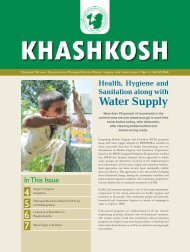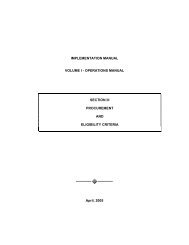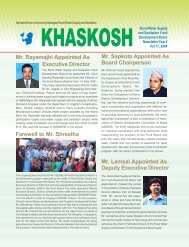ANNUAL REPORT_2008.pdf - Rural Water Supply and Sanitation ...
ANNUAL REPORT_2008.pdf - Rural Water Supply and Sanitation ...
ANNUAL REPORT_2008.pdf - Rural Water Supply and Sanitation ...
Create successful ePaper yourself
Turn your PDF publications into a flip-book with our unique Google optimized e-Paper software.
Board’s Working Modalities <strong>and</strong> Guiding Principles<br />
<br />
<br />
<br />
<br />
<br />
<br />
<br />
<br />
<br />
<br />
<br />
<br />
Dem<strong>and</strong> Driven <strong>and</strong> Participatory Approach<br />
Resource Allocation through SOs <strong>and</strong> Communities<br />
Local Resource Mobilization with Informed Choice of Technical <strong>and</strong> Service Level Options<br />
Community Procurement <strong>and</strong> Financial Transparency<br />
Equity in <strong>Water</strong> <strong>Supply</strong>, Health, Hygiene <strong>and</strong> <strong>Sanitation</strong><br />
Social Inclusion (Women, IP, Dalit <strong>and</strong> Disadvantaged People)<br />
Capacity Building of Governmental <strong>and</strong> Non-governmental Organizations<br />
Quality Control through Participatory Monitoring <strong>and</strong> Evaluation<br />
Cost-Effective Service<br />
Operation <strong>and</strong> Management of Schemes by Communities<br />
Backing Government’s Goal of Poverty Alleviation<br />
Coordination, Linkages <strong>and</strong> Partnership Building with Local Authorities <strong>and</strong> Other Programs<br />
Programme Components<br />
The project takes a holistic approach to delivering inclusive<br />
<strong>and</strong> sustainable rural water supply <strong>and</strong> sanitation services by:<br />
(a) integrating health <strong>and</strong> hygiene programs with water<br />
supply; (b) strengthening governmental <strong>and</strong> nongovernmental<br />
capacities to facilitate the delivery of rural water<br />
supply <strong>and</strong> sanitation services; (c) strengthening community<br />
capacity to operate <strong>and</strong> maintain improved water supply <strong>and</strong><br />
sanitation facilities; (d) empowering <strong>and</strong> providing<br />
opportunities to women <strong>and</strong> girls as the primary beneficiaries<br />
by involving them in planning, implementing, <strong>and</strong> managing<br />
the schemes; (e) ensuring that Dalits <strong>and</strong> Janajati (indigenous<br />
peoples <strong>and</strong> nationalities) households in the catchment areas<br />
served are also included <strong>and</strong> that these groups participate fully<br />
in the planning, implementation <strong>and</strong> management of the<br />
schemes; (f) assisting women to use the time saved in collecting<br />
water to identify opportunities to increase incomes <strong>and</strong> receive<br />
non-formal education.<br />
Scheme Cycle<br />
The schemes generally take about 36 calendar<br />
months with Pre-development, Development <strong>and</strong><br />
Implementation Phases to complete, <strong>and</strong> are divided<br />
into cycles that are designed to account for seasons,<br />
harvests <strong>and</strong> holidays. These have major significance<br />
for the timing of operations, which must take into<br />
consideration factors such as the availability of labor,<br />
<strong>and</strong> prevailing weather conditions <strong>and</strong> their impacts<br />
on site accessibility <strong>and</strong> construction. These factors<br />
are also important to consider for measuring the<br />
yield of different water sources, which vary widely<br />
by season. Post- Implementation Phase consists of<br />
24 calendar months considering the sustainability<br />
of the scheme.<br />
2 · RWSSFDB Annual Report 2008



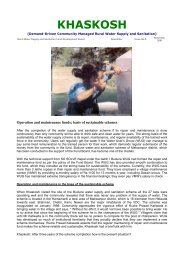
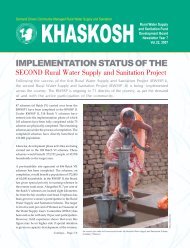
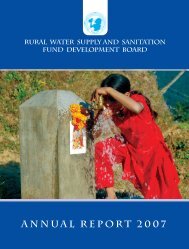
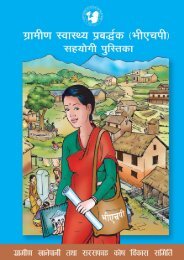


![vfg]k fgL tyf ;/;kmfOsf] If]qdf sf]if ljsf; ;ldltsf] cjwf/0ff pTs[i7 cEof](https://img.yumpu.com/38832733/1/190x245/vfgk-fgl-tyf-kmfosf-ifqdf-sfif-ljsf-ldltsf-cjwf-0ff-ptsi7-ceof.jpg?quality=85)

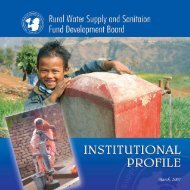
![Request for Proposals RFP # [162] - Rural Water Supply and ...](https://img.yumpu.com/38832347/1/184x260/request-for-proposals-rfp-162-rural-water-supply-and-.jpg?quality=85)
